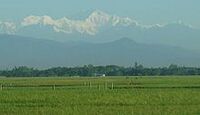Haipoon
This article is incomplete because it is pending further input from participants, or it is a work-in-progress by one author. Please comment on this article's talk page to share your input, comments and questions. Note: To contribute to this article, you may need to seek help from the author(s) of this page. |
Haipoon, Abode of Peace ที่สงบสุข | |
|---|---|
| Motto: Peace and Unity | |
| Capital | Bangoon |
| Largest | Mon Hoi |
| Official languages | Haipoonese |
| Demonym(s) | Haipoonese |
| Government | Decentralised Oligarchal Theocracy |
• Sangharaja | Amborn Prasatthapong |
• Custodian of State | Theewan Minh |
| Population | |
• Estimate | 76,368,850. |
| Currency | Haipoon Rupee (HPR) |
| Date format | dd.mm.yyyy |
| Driving side | left |
Haipoon, officially Haipoon, Abode of Peace (Haipoonese: ที่สงบสุข), is a country in the South-East Ochran region of the world. Located on a large peninsular at the entrance of the Ozeros Sea, Haipoon shares land borders with Uluujol to the north, and Jhengtsang to the west, as well as maritime borders with Pulau Keramat to the south-west, Lion's Rock and Onekawa-Nukanoa to the south, and Fuyang to the east.
Etymology
History
Ancient
Kingdom of Haipoon
Revolution
Industrial Reforms
Contemporary History
Geography
Haipoon is located on a large peninsular in South-East Ochran at the entrance of the Ozeros Sea. Haipoon shares land borders with Uluujol to the north, and Jhengtsang to the west, and maritime borders with Pulau Keramat to the south-west, Lion's Rock and Onekawa-Nukanoa to the south, and Fuyang to the east.
Climate
Enviroment
Haipoon comprises several distinct geographic regions, and is home to a number of river systems. The Di'roong delta in the nations north makes the predominantly rich fertile low-lying flat land prone to seasonal flooding. Due to the agricultural importance of the region, it is intensely developed and densely populated. Central Haipoon is home to large plains, while large portions of Haipoon's western borders are mountainous, and the south is mostly hilly and densely forested.
Politics & Government
Government
Haipoon is highly decentralised oligarchal theocracy which operates under a ‘two-system’ model having both a ‘spiritual’ and ‘secular’ government. The Sangharaja, also known as Supreme Monk, is the head of state, as well as highest ranking religious authority being the head of Haipoon’s state religion. The Sangharaja is aided in his duties by the Sangha Supreme Council, the ultimate authority for all ecclesiastical matters within Haipoon, and who’s leadership consists of the country's highest-ranking monks. In parallel, the Custodian of State, is the highest acting ‘civil and political’ authority of state, acting as head of government, and appointed from the ‘Council of Lords’ comprised of representatives from Haipoon's noble landed families. The Custodian is elected for a five-year term, but may be removed at any time by either the Council of Lords or Shangharaja. Haipoons two system model causes an uneasy and delicate balance of power between the religious establishment and landed nobility within the nation.
Being a highly decentralised state however, the majority of power in governance lies with local temples and lords under the Mandala system of Mueang and Nakhons.
Shangharaja and Supreme Council
The Sangharaja, also known as Supreme Monk, is the head of state, as well as highest ranking religious authority being the head of Haipoon’s state religion. The Sangharaja is aided in his duties by the Sangha Supreme Council, the ultimate authority for all ecclesiastical matters within Haipoon, and who’s leadership consists of the country's highest-ranking monks. The armed forces, judiciary, state religion, and other key government institutions are subject to the Supreme Monk.
The Shangharaja is appointed to the office for life. Upon death of the Shangharaja, candidates are selected from amongst Haipoons temples. The Shangharaja appoints the Sangha supreme council.
Custodian of State and Council of Lords
Mandala System
As a highly decentralised state, the majority of governance stems from Haipoon's local communities called Mueang (Muong in the South), or Nakhon (cities). Mueang and Nakhon are defined by their center of influence, rather than physical boundaries which are often blurred. Different villages and individual families may owe allegiance to different Mueangs.
Mueang are governed from, and include the areas of influence surrounding local temples. Nakhon are cities often comprised of numerous Mueang, and as such ruled by a council of monks from amongst the temples, often from the most significant temple in the region.
Khun
After land owned directly by temples, local land owners called Khun (lords) own the majority of land in rural Haipoon. Comprising of powerful families descended from the warrior class, Khun were traditionally tasked with protecting local regions from outside attack, and thus have been gifted land and limited power by local temples.
Khun continue to have the responsibility of providing tributes and defense to local temples, but now exist as a powerful social class with the ability to elect representatives from amongst their ranks onto the Council of Lords, who in turn elect secretariats of state, and appoint the Custodian of State.
Khun lands are lived and worked on by the peasant class.
Law
Administrative divisions
Foreign Relations
Military
Economy
Agriculture
Tourism
Research & Development
Demographics
Ethnic Groups
Languages
Religion
Education
Health
Culture
Lạksṇa (ลักษณะ) often translated as nature, character, or style of the Haipoonese people, is a Haipoonese concept incorporating traditional practices and values. Laksna can be viewed from several perspectives and can include culture, custom, ethic, etiquette, formality, manner, meaning, method, protocol, style, and customary law. One view is that Laksna 'controls interpersonal relationships' as it guides the interactions of meetings, and provides identity to individuals. Another view is through ethics, that it’s a practiced code of conduct.
Society
Haipoon is a collectivistic society. Loyalty towards the family, local community, and the nation, are central aspects to Haipoonese culture.
Other Haipoonese collective values include:
- Putting harmony of group above the expression of individual opinions. - Forgoing of personal freedom for the sake of society's stability and prosperity. - Preference for social harmony. - Concern with socio-economic prosperity and the collective well-being of the community. - Loyalty and respect towards figures of authority. - Preference for collectivism.



